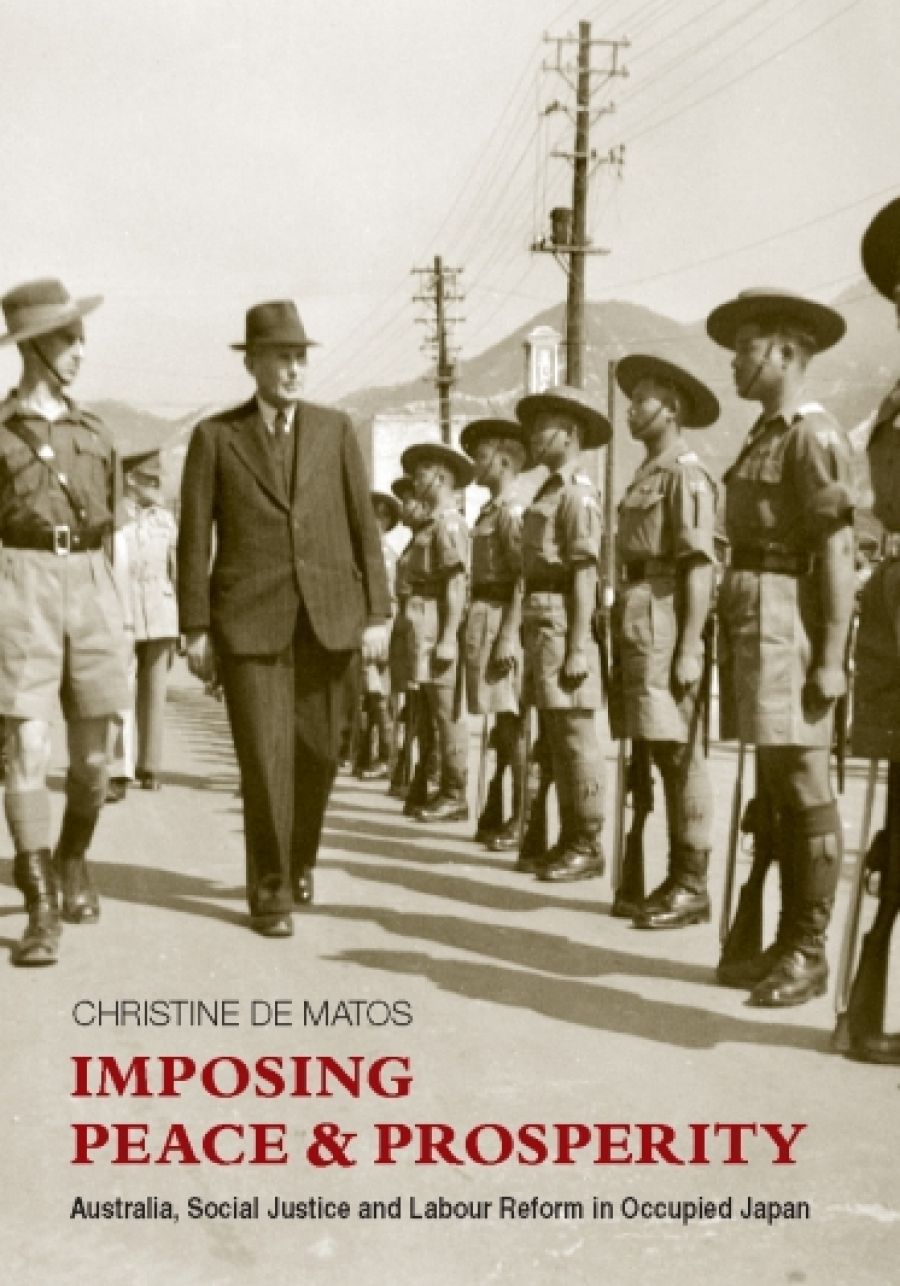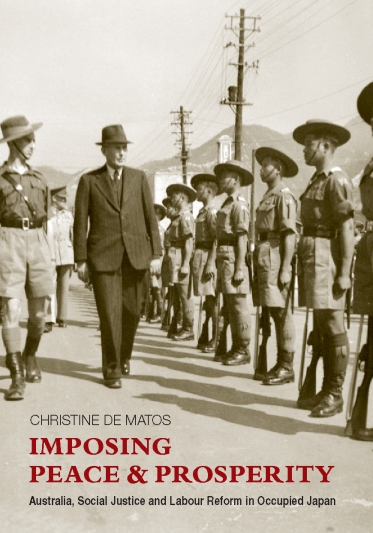
- Free Article: No
- Contents Category: History
- Review Article: Yes
- Article Title: Historical trajectories
- Online Only: No
- Custom Highlight Text:
In 2004, the year after the US-led invasion of Iraq, Stefan Halper, a senior diplomat who had served Republican administrations from Nixon to Reagan, published America Alone: The Neo-Conservatives and the Global Order, a celebrated and scathing critique of the neo-conservative influence on George W. Bush’s foreign policy. It was different after World War II, thought Halper, when US forces were welcomed as liberators. The occupations of Germany and Japan became models of what could be achieved. It is a theme that has found some resonance in the Obama administration.
- Book 1 Title: Imposing Peace and Prosperity
- Book 1 Subtitle: Australia, Social justice and Labour reform in occupied Japan
- Book 1 Biblio: Australian Scholarly Publishing, $39.95 pb, 427 pp
- Book 1 Cover Small (400 x 600):

- Book 1 Cover (800 x 1200):

In Iraq, the refrain from supporters of the war has been to let the military get on with the job, unhindered either by reluctant Allies or domestic liberals. In postwar Japan, there were similar calls. The General David Petraeus of the era was General Douglas MacArthur, the Supreme Commander of Allied Forces in the Pacific (SCAP, a term that came to apply to MacArthur himself). De Matos does not explain the extent to which MacArthur exploited his ‘interim directive’ to administer Japan subject to the very broad guidelines issued by the Allied control machinery, but she does capture the authoritarian nature of MacArthur’s administration. She also underlines the reluctance of Washington to interfere with that administration. When the British quietly approached the United States in early 1949, on behalf of all thirteen nations on the Far Eastern Commission, the policy body responsible for the Far Eastern settlement, to complain about the direction of SCAP labour policy, the US State Department conceded that this had become a ‘source of friction in our international relations’. Despite this concern of ‘friendly FEC countries’, however, the British were informed that the United States was reluctant ‘to interfere with or to challenge “the discretion of SCAP in the matter”’.
In 2009 this would end the matter. De Matos, however, paints a very different view of Australia’s role in the US occupation of Japan from 1945 to 1952. It was a comprehensive policy (albeit one that ‘contained the contradictions between domestic, nationalist agendas and internationalist aspirations’) that went well beyond the desire for a ‘harsh peace’ that is the usual view of historians. Australia approached the peace settlement from a combination of both social justice and security considerations. The book does not elaborate in detail on the latter (there is no discussion, for example, of the impact of NSC48, Truman’s National Security Council Resolution on the role of Japan in Allied strategy), apart from making the point that is widely made today: democracies do not declare war on one another. The book’s focus is on Australian attempts to ensure that Japan would be democratised. The Australian definition of democracy, however, was rather different from that used by SCAP. It was not enough to promote political democracy; to this had to be added ‘economic democracy’. A central tenet here was the role of trade unions, fashioned by European and Australian experiences. Rights of collective bargaining and taking strike action should be preserved. Civil servants were to be accorded the same rights as their counterparts in the private sector. Industrial activity should be seen as a legitimate reflection of economic problems rather than a sign of creeping communism.
It was for this reason that Australian diplomats often found themselves tarred by SCAP as aiding communism. H.V. Evatt and his officials sought to strengthen Allied control machinery, as opposed to that run by SCAP, and in so doing received support from other Allied powers, including the Soviet Union. Herein de Matos makes a telling point in her assertion that there has been inadequate attention paid to Australian diplomats, such as Keith Eggleston and Patrick Shaw (the role of William Macmahon Ball has long been acknowledged), in their attempts to influence postwar reform in Japan. From the beginning, they faced implacable opposition from the Americans. At times there was pressure to have delegates, such as Macmahon Ball, recalled. There was also considerable pressure placed on Australia by American back-door manoeuvres in London.
Readers will find this curious. How did Australia come to be so dominant in the debates over occupation policy? De Matos tells us that Macmahon Ball represented the Commonwealth on the important control body to assist the FEC and SCAP, the Allied Council for Japan. This was the site of some of the great battles with the United States involving Australian policy. The prominence of Macmahon Ball was due to the fact that Australia sat on a body composed of the veto-wielding Great Powers (four then – France was not a member). The idea that the British Commonwealth offered a ‘third way’, between the United States and the USSR, was something of a revolution in Empire foreign policy and goes some way to explaining the confidence of the Australians in tackling the Americans over a range of postwar policies, of which Japan was but one example. De Matos does, however, develop a rich narrative on Australian-British policy coordination (with the exception of poor relations with the British ambassador to Japan, Alvary Gascoigne) designed to influence SCAP.
The current debate in Iraq is whether the Obama administration will substantially undo the destruction wrought by Bush’s unilateralism. In postwar Japan it was the other way around. American policy was subject to a ‘reverse course’ with the onset of the Cold War. The occupation had started with reformist aims, but descended into a ‘more reactionary approach’ as fears of communism took hold. Because of this, Patrick Shaw, whose records have materially influenced de Matos, concluded in 1949 that the ‘reverse course’ would see ‘development in Japan as primarily an American and not an Allied concern’. De Matos noted, however, that this had been the case from the beginning of the occupation. What had changed by 1949 was that democratic rights would be subordinate and that government would become more authoritarian – and would deliver Japan as a long-term bastion against communism.
De Matos concludes that the clash over occupation policy was not one driven by MacArthur’s personal style or Evatt’s idealism, but rather was a reflection of two very antithetical ‘historical trajectories’. Laissez-faire capitalism did not sit well with Australian social democracy. Australia and the United States were frontier states and the occupation in Japan became one of ‘competing frontier ideologies’.
This makes it a timely book, as Australia seeks to refashion not only its post-Cold War (and post-Wall Street collapse) foreign policy, but also reflects on the trajectory of the American relationship. It reminds us that US policy might be based less on the vagaries of individual administrations than on forces that date well before 9/11. It is also a reminder that American occupation policy in Japan, as the leading US writer on the subject, Chalmers Johnson, has long reminded us, is still a matter of considerable concern, and thus a concern to key regional players such as Australia. Yet I wonder whether Australians today would articulate such alternatives to US policies in the manner described in this work. If they do not, and if I have followed de Matos correctly, the ideology that informed postwar occupation policy was the product of an Australia that has long since ceased to exist.


Comments powered by CComment